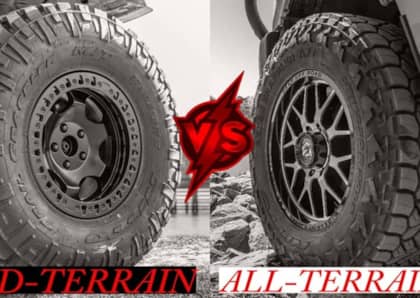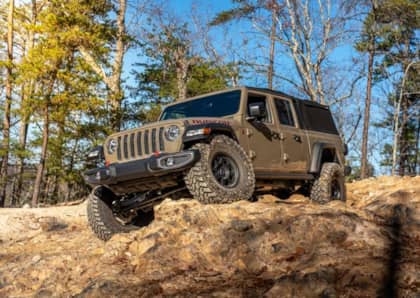Mud Terrain Longevity—How To Get The Most Miles Out Of Your Aggressive Tread Tire
Everyone loves a mud-terrain tire. Not only do you get an aggressive tread design that excels off-road, but you also get a tough, puncture resistant sidewall and the masculine curb appeal that only an M/T can provide. And thanks to modern tire design technology, you can have a uniform mud-terrain that provides above-average ride comfort while also generating very little road noise. But although tire manufacturers have discovered ways to tame the mud terrain on the highway without sacrificing off-road capability, tread life expectancy is something that most manufactures do not provide. In a word, the reason for this is “variables.” Due to the diverse conditions most mud terrain’s see throughout the course of their service life, there is no way to guarantee treadwear longevity. For an idea of the kind of variables that can alter the longevity of a mud terrain and what you can do to ensure yours go the distance, keep reading.
What Affects Tread Wear?
The Vehicle Itself

One of the biggest reasons you don’t find a treadwear warranty on a mud-terrain stems from the types of vehicles you typically find them on. Heavy trucks, Jeeps and SUV’s with four-wheel drive are the usual customers—and many of them put their aggressive tread to good use off the beaten path.
How You Use Your Tires

Perhaps the biggest influence on a mud terrain’s treadwear is how you use them. If you’re on the trail and especially if you’re navigating rocks, the tread blocks are bound to see more wear than if you simply use them to commute to work. Tires like Nitto’s Trail Grappler are designed with a 3-ply sidewall that’s very resistant to puncture, but prolonged exposure to rough terrain is hard on any arrangement, size and style of tread block.
Tire Size

It may surprise you, but tire size can affect treadwear as well—especially when it comes to stretched fitments. When a tire is stretched to fit a rim that’s specified for a wider tire, its profile is altered, as well as its intended wear pattern. Stretched fitments place added pressure on the tire’s sidewall, leading to (among other things) increased and irregular wear on the tire’s edges.
Tire Pressure

Maximum tread life begins with proper tire inflation. Although the raised maximum psi rating printed on the sidewall should be observed in instances of heavy towing where peak weight carrying capacity is required, the manufacturer’s pressure recommendation should be followed for optimum tread longevity. Remember, over-inflation leads to increased wear on the tire’s crown while under-inflation (which often can’t be spotted with the naked eye) will eat away the tread on the tire’s edges. So if you spot abnormal or excessive wear in these areas, the first step in solving the problem is to check inflation pressure.
Airing Down Saves On Tread Wear

Believe it or not, running a lower air pressure to increase a tire’s footprint while off-roading can actually save tread life. By increasing the amount of contact surface area of the tire, the slip rate is reduced when traversing rough terrain. Better grip (or more importantly, less spin) preserves tread life, while also affording you and your vehicle the ability to conquer trail obstacles more easily. Just remember to air back up to the manufacturer’s recommended pressure when/if you get back on the pavement.
Vehicle Alignment

Large mud terrains often accompany the installation of a suspension lift on trucks, Jeeps and other SUV’s. This alteration in the suspension system typically alters the alignment of the vehicle’s front wheels as well. Improper alignment (even if a pull isn’t easily detectable in the steering wheel) can increase tread wear significantly. Any time you install a lift, bigger wheels and larger tires, always have a competent professional shop perform a precise front-end alignment.
Road Conditions

Your specific road conditions and driving environment can have a direct impact on tread wear. For rural mud terrain owners, gravel roads produce increased tire slip and even loss of traction, not to mention that the small pieces of stone the tread blocks encounter can chip away at them. However, city streets tend to inflict the most damage when it comes to tread life. The biggest culprit lies in potholes and quick or emergency lane changes and maneuvers. As for the highway, steady-state cruising is typically the easiest on tread life, as most interstate surfaces are better maintained than city surface streets (and certainly gravel roads).
Your Driving Style

The way you drive can accelerate your tire’s treadwear considerably. As mentioned, emergency lane changes or other maneuvers can rob you of precious tread life, but so can instances of hard braking and acceleration. Remember, not only does aggressive driving burn through fuel, it also burns through tires! However, when you couple a conservative driving style with proper tire maintenance (namely regular rotations, pressure checks, alignment and balancing), you’ll be able to extract maximum longevity out of a mud terrain (or any type of tire). With regular upkeep and modest driving habits, a set of M/T’s can easily give you many miles of loyal service.
More From Driving Line
- Proper tire rotation plays a major role in maximizing tread life, but that’s just the tip of the iceberg when it comes to tire maintenance. Find out more here.







